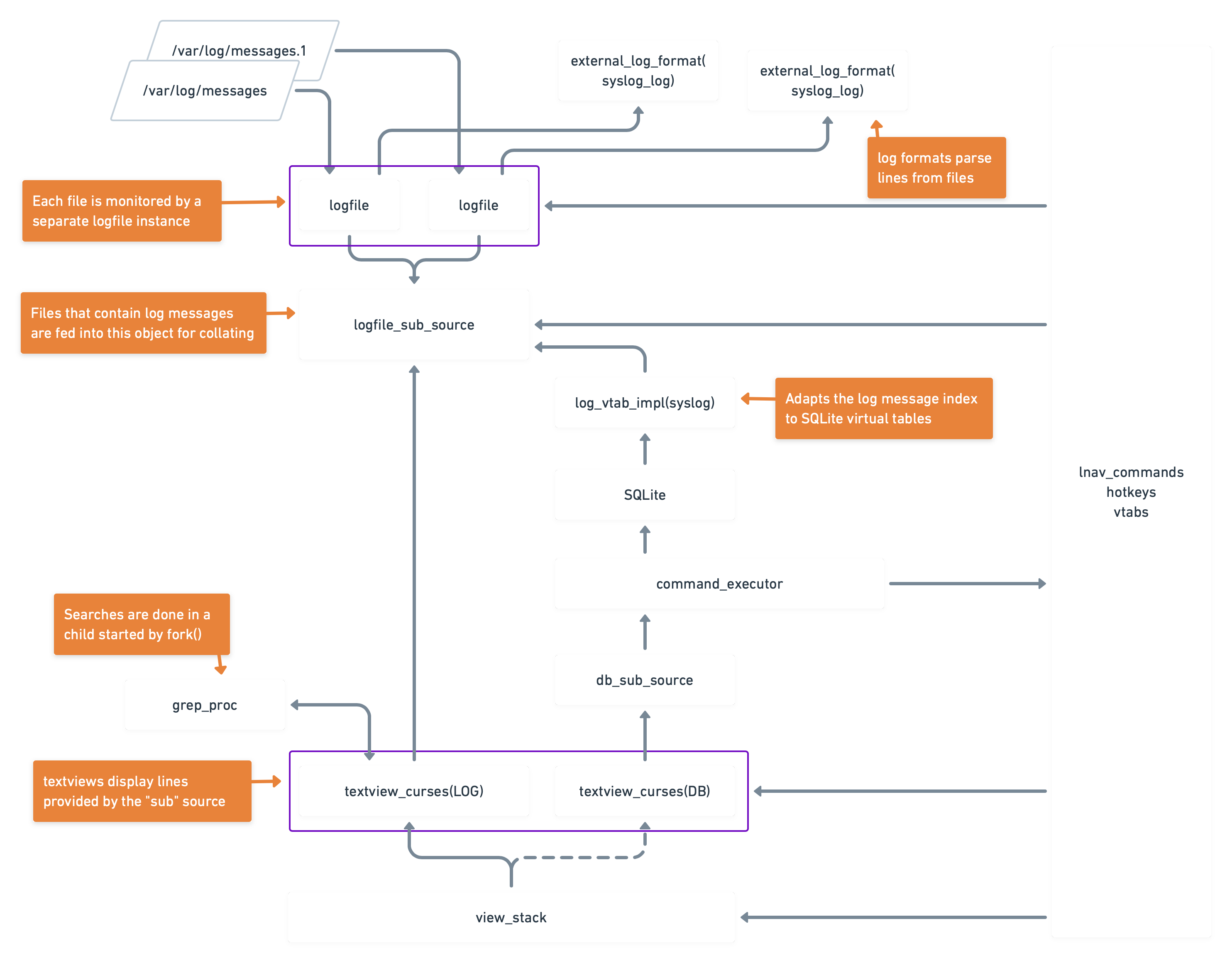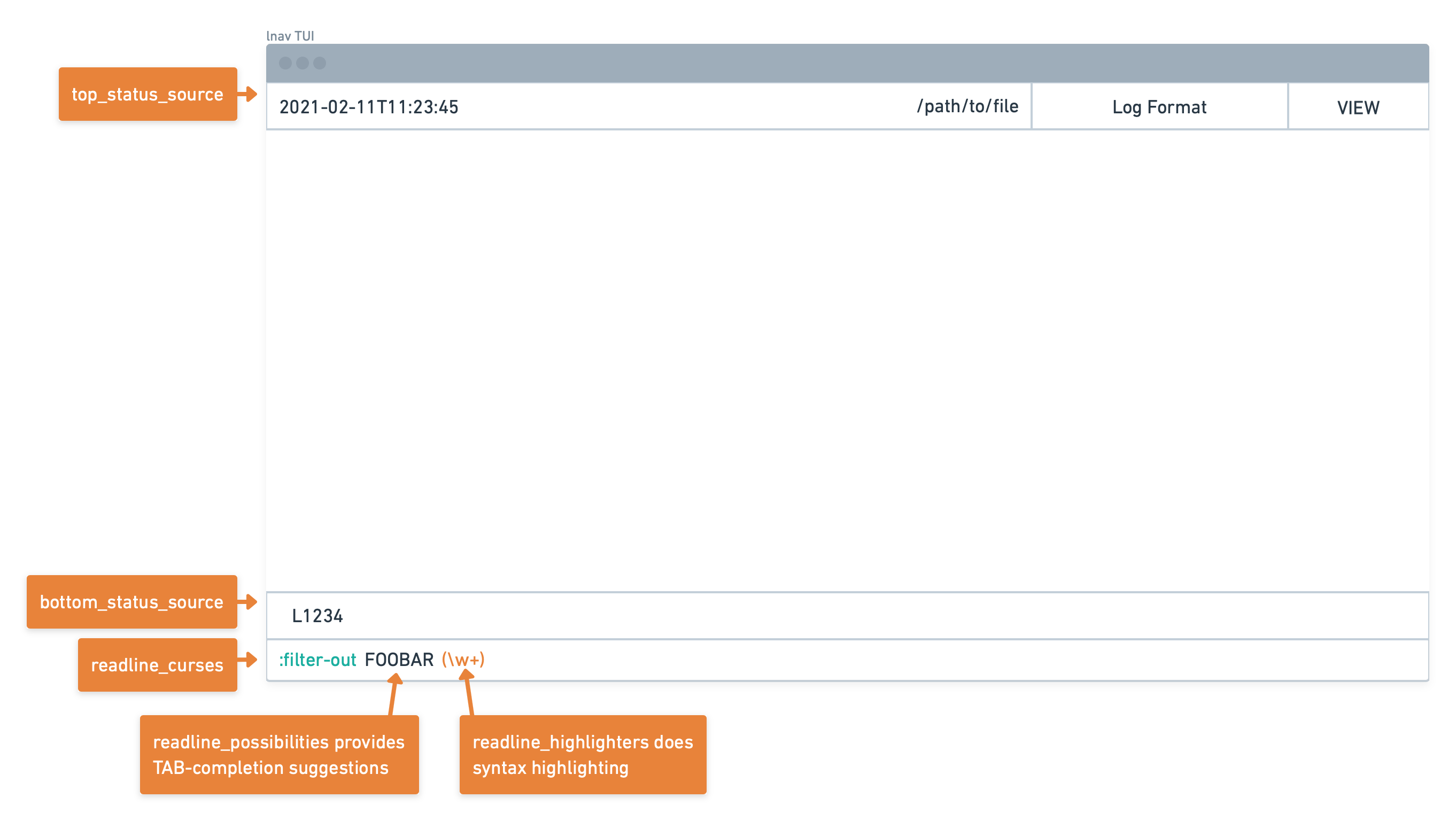5.3 KiB
Architecture
This document covers the internal architecture of the Logfile Navigator (lnav), a terminal-based tool for viewing and analyzing log files.
Goals
The following goals drive the design and implementation of lnav:
-
Don't make the user do something that can be done automatically.
Example: Automatically detect log formats for files instead of making them specify the format for each file.
-
Be performant on low-spec hardware.
Example: Prefer single-threaded optimizations over trying to parallelize
-
Operations should be "live" and not block the user from continuing to work.
Example: Searches are run in the background.
-
Provide context-sensitive help.
Example: When the cursor is over a SQL keyword/function, the help text for that is shown above.
-
Show a preview of operations so the user knows what is going to happen.
Example: When entering a
:filter-outcommand, the matched parts of the lines are highlighted in red.
Overview
The whole of lnav consists of a log file parser, text UI, integrations with SQLite, command-line interface, and commands for operating on logs. Since the majority of lnav's operations center around logs, the core data-structure is the combined log message index. The message index is populated when new messages are read from log files. The text UI displays a subset of messages from the index. The SQLite virtual-tables allow for programmatic access to the messages and lnav's internal state.
File Monitoring
Each file being monitored by lnav has an associated logfile
object, be they plaintext files or files with a recognized format. These
objects are periodically polled by the main event loop to check if the file
was deleted, truncated, or new lines added. While reading new lines, if no
log format has matched yet, each line will be passed through the log format
regular expressions to try and find a match. Each line that is read is added
to an index
Why is mmap() not used?
Note that file contents are consumed using pread(2)/read(2) and not
mmap(2) since mmap(2) does not react well to files changing out from
underneath it. For example, a truncated file would likely result in a
SIGBUS.
Log Messages
As files are being indexed, if a matching format is found, the file is "promoted" from a plaintext file to a log file. When the file is promoted, it is added to the logfile_sub_source, which collates all log messages together into a single index.
Timestamp Parsing
Since all log messages need to have a timestamp, timestamp parsing needs to be
very efficient. The standard strptime() function is quite expensive, so lnav
includes an optimized custom parser and code-generator in the
ptimec component. The code-generator is used at compile-time
to generate parsers for several common formats.
Log Formats
log_format instances are used to parse lines from files
into logline objects. The majority of log formats are
external_log_format objects that are create from
JSON format definitions. The
built-in definitions are located in the formats directory. Log
formats that cannot be handled through a simple regular expression are
implemented in the log_format_impls.cc file.
User Interface
The lnav text-user-interface is built on top of ncurses. However, the higher-level functionality of panels, widgets, and such is not used. Instead, the following custom components are built on top of the ncurses primitives:
- view_curses - Provides the basics for text roles, which
allows for themes to color and style text. The
mvwattrline()function does all the heavy lifting of drawing "attributed" lines, which are strings that have attributes associated with a given range of characters. - listview_curses - Displays a list of items that are provided by a source.
- textview_curses - Builds on the list view by adding support for searching, filtering, bookmarks, etc... The main panel that displays the logs/plaintext/help is a textview.
- statusview_curses - Draws the status bars at the top and bottom of the TUI.
- vt52_curses - Adapts vt52 escape codes to the ncurses API.
- readline_curses - Provides access to the readline library. The readline code is executed in a child process since readline does not get along with ncurses. The child process and readline is set to use a vt52 terminal and the vt52_curses view is uses to translate those escape codes to ncurses.
The following diagram shows the underlying components that make up the TUI:

